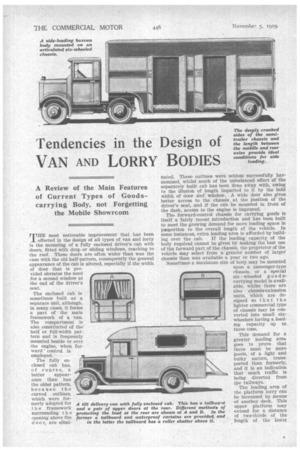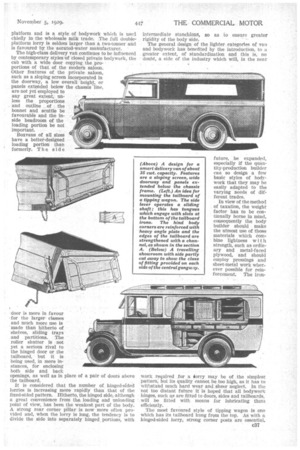Tendencies in the Design of
Page 166

Page 167

Page 168

If you've noticed an error in this article please click here to report it so we can fix it.
VAN AND LORRY BODIES
A Review of the Main Features of Current Types of Goodscarrying Body, not Forgetting the Mobile Showroom
THE most noticeable improvement that has been effected in the design of all types of van and lorry is the mounting of a fully enclosed driver's cab with doors, fitted with drop or sliding windows, reaching to the roof. These doors are often wider than was the ease with the old half-pattern, consequently the general appearance of the cab is altered, especially if the width of door that is provided obviates the need for a second window at the end of the driver's seat.
The enclosed cab is sometimes built as a separate unit, although, in many eases, it forms a part of the main framework of a van. The compartment is also constructed of the half or full-width pattern and is frequently mounted beside or over the engine, when forward ' control is employed.
The fully enclosed cab has, of course, a
better appearance than has the older pattern, because the curved outlines, which were formerly adopted for t h e framework surrounding t Ii e opening above the d 00 r, are elimi
hated. These outlines were seldom successfully harmonized, whilst much of the unbalanced effect of the separately built cab has been done away with, owing to the illusion of length imparted to it by the bold width of door and window. A wide door also gives better access to the chassis at the position of the driver's seat, and if the cab be mounted in front of the dash, access to the engine is improved.
The forward-control chassis for carrying goods is itself a fairly recent introduction and has been built to meet the growing demand for more loading space in p2oportion to the overall length of the vehicle. In some instances, extra loading area is afforded by build ing over the cab. If the loading capacity of the body required cannot be given by Making the best use of the forward part of the chassis, the proprietor of the vehicle may select from a greater number of larger chassis than was available a year or two ago.
Sometimes a maximum size of body may be mounted upon a passenger-type chassis, or a special six wheeled good scarrying model is avail able, whilst there are also chassis-extension units, Which are de signed so that the lighter commercial type of chassis may be con verted into small sixwheelers having a loading capacity up to three tons.
This demand for a greater loading area goes to prove that there must be more goods, of a light and bulky nature, trans ported than formerly, and it is an indication that much traffic is being diverted from the railways.
The loading area of the platform lorry can be increased by means of another deck. This upper platform may extend for a distance of two-thirds of the length of the lower platform and is a style of bodywork which is used chiefly in the wholesale milk trade. The full doubleplatform lorry is seldom larger than a two-tonner and is favouredby the aerated-water manufacturer.
The high-class delivery van continues to be influenced by contemporary styles of closed private bodywork, the cab with a wide door copying. the proportions of that of the modern saloon. Other features of the private saloon, such as a sloping screen incorporated in the doorway, a low overall height, or panels extended below the chassis "line, are not yet employed to any great extent, unless the proportions and outline . of the bonnet and scuttle be favourable and the Inside headroom of the loading portion be not important.
13oxvans of all sizes have a better-designed loading portion than formerly. The side
• door is more in favour , for the la-rger, classes and much more use is 'made than hitherto of shelves, sliding trays and partitions. The roller shutter is not yet a serious rival to the hinged door or the tailboard, but it is being used, in more instances, for enclosing both side and back openings, as well as in place of a pair of doors above the tailboard.
It is considered that the number of hinged-sided lorries is increasing more rapidly than that of the fixed-sided pattern. Hitherto, the hinged side,.although a great convenience from tha loading and unloading point of view, has been the weakest. part of the body. A strong rear corner pillar is now more often provided and, when the lorry is long, the tendency is to divide the side into separately hinged. portions, with
intermediate stanchions, so as to ensure greater rigidity of the body side.
The general design of the lighter. categories of van and .bodywork has benefited by the introduction, to a greater extent, of standardization and this is, no doubt, a side of the industry which will, in the near
future, be expanded, especially if the quantity-production builder can so design a few basic styles of bodywork that they may be easily adapted to the varying needs of different trades.
In view of the method of taxation, the weight factor has to be continually borne in mind, consequently the body builder should make the utmost use of those materials which Combine lightness with strength, such as ordinary and metal-faced plywood, and should employ pressings and sheet-metal work wherever possible for reinforcement. The iron
.work required for a sorry may be of the simplest .pattern, but its quality cannot be.too high, as it has to withstand much hard wear and sheer neglect. In the 'not too distant future' it is hoped that all bodywork hinges, such as are fitted to doors, sides and tailboards,
• . will be fitted with means for lubricating them efficiently. .
The most favoured style of tipping wagon is one which has its tailboard hung frem the ton. As with a hinged-sided lorry, strong corner posts are essential. c37 These two corner posts and the bark bar of the body must also be strongly plated, so as to form a rigid transverse unit. If the tailboard be hung froin a crossrod, this must be of substantial section, in order that the alignment of the hinge centres shall be maintained. Separate hinge bearings should be a satisfactory method of suspension, if the bearings be of ample dimensions and if they be well fitted.
The chassis having small wheels mounted upon both axles, or only to the rear one, helps to solve many problems of transportation. The output of this variety of chassis has probably more than doubled during the past 12 months. By this means a low platform is available, without having obtruding wheel-arches; higher Toads are possible without the necessity of making detours to avoid overhead bridges, whilst heavy and concentrated loads have a more favourable position as regards the centre of gravity.
• The small-wheeler also makes an ideal side-loader, and has facilitated and cheapened the collection of house refuse, apart from its operation being conducted under more hygienic conditions than were possible with the old pattern of refuse wagon.
The most interesting development in connection with bodywork that is designed for livestock transport has been in meeting the demand for larger vehicles. Horseboxes have chiefly been constructed to carry two animals, but now larger raddels of chassis have mounted upon them bodies to carry up to six horses. In some instances, hounds may be carried as well as horses, when the vehicle is used in connection with hunting, unless a separate van be provided for the houlads.
The double-deck livestock lorry is now well established. The mounting of the upper floor as a lifting platform has the advantage that the lorry may be used for larger animals, as the occasion demands.
The livestock-carrying lorry used for transporting cattle is also sometimes designed as a cross-loader. Each side of the body lets down to form a ramp. There are transverse partitions, so that the body is divided into a number of separate stalls, the animals standing across the body.
The comatercial-motor vehicle not only carries goods, but may often be used to assist in selling them. Many of the larger concerns are providing their representatives with travelling showrooms. This class of vehicle consists of a large boxvan, and usually has a main back entrance leading to a central gangway.
On each side the body is fitted with chests of drawers, cupboards and glass-fronted cases, the latter being provided to display the goods to the best advantage.
The clerestory type of roof is favoured, because it gives plenty of natural lighting and leaves the sides of the vehicle free for the disposal of the interior storage and display equipment besides giving light from above the goods. The travelling showrOom may also be designed as a means for demonstrating, the use of some particular article, such as a patent fuel. In this instance the van opens out to form a stage or platform, a broad flight of steps is added to afford easy access to the floor level and the body of the van is finished to represent the exterior of a cottage or bungalow.




































































































































































































































































